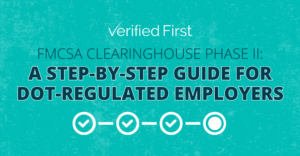
As of July 2024, over 175,000 drivers hold a “prohibited” status with the Federal Motor Carrier Safety Administration’s (FMCSA) Drug and Alcohol Clearinghouse. With the FMCSA Clearinghouse Phase II going into effect on November 18, 2024, these drivers and their employers must prepare for the new updates and requirements.
Phase I, which rolled out on January 6, 2021, introduced a centralized database designed to monitor and record violations of the FMCSA’s drug and alcohol testing program by CDL drivers. With Phase II, the FMCSA aims to remove “prohibited” CDL drivers from the roads in an effort to improve safety and reduce drug and alcohol violations.
These changes are designed to enhance road safety by ensuring that drivers who have violated drug and alcohol regulations undergo proper evaluation, treatment, and monitoring before being allowed to return to duty. For employers, this means new responsibilities in verifying a driver’s status, ensuring compliance with the Clearinghouse requirements, and maintaining detailed records of each driver’s progress through the return-to-duty process.
The implementation of Phase II brings significant changes to the way DOT-regulated employers must manage their drivers. In this step-by-step guide, we will walk you through the key updates and how they impact your company’s compliance responsibilities.
The goal of the FMCSA Drug & Alcohol Clearinghouse-II regulation is to ensure that only qualified drivers can obtain and retain CDLs. Beginning November 18, 2024, this update requires State Driver Licensing Agencies (SDLAs) to revoke the commercial driving privileges of individuals with “prohibited” Clearinghouse statuses. This action will result in the individual’s CDL being downgraded and suspended until the driver completes the return-to-duty (RTD) process.
The second phase of the Clearinghouse rule introduces critical new requirements aimed at enhancing road safety. By ensuring that drivers who have violated drug and alcohol regulations cannot retain their commercial driving privileges, these changes help keep unsafe drivers off the road and protect public safety.
Let’s explore the key regulations Phase II presents to DOT-regulated employers:
As the FMCSA Clearinghouse Phase II comes into effect, employers are tasked with several important responsibilities to ensure compliance and protect road safety. Understanding these obligations is essential to avoid penalties and maintain compliance. Here’s a breakdown of key employer responsibilities under the new FMCSA regulations:
These new regulations offer clear safety benefits, however, they also create additional responsibilities for DOT-regulated employers. One of the most important responsibilities is staying up to date with driver statuses in the Clearinghouse to ensure compliance with all federal regulations.
Employers must ensure that any driver they hire or retain is not listed as "prohibited" due to drug or alcohol violations. For DOT organizations, this includes checking with the Clearinghouse during pre-employment screening, plus ongoing queries for active drivers. Failure to verify a driver’s status could result in serious consequences, including fines and potential legal action.
Commercial drivers who fail a DOT drug or alcohol test, refuse to take these tests, or are classified as "prohibited" in the FMCSA Clearinghouse must be removed from safety-sensitive duties, such as driving, and immediately enrolled in the DOT return-to-duty process. Phase II requires drivers to complete a series of steps before returning to safety-sensitive duties.
These steps include:
DOT employers must maintain detailed records of the RTD process, ensuring all steps are properly documented and that the driver is cleared for return by the SAP before resuming safety-sensitive duties.
These new regulations bring additional responsibilities, particularly around monitoring and managing drivers with drug and alcohol violations. Before November 18, 2024, employees should take proactive steps to ensure full compliance and avoid disruptions to their operations.
Below are key actions you can take to prepare for the changes:
With the new Clearinghouse regulations coming into effect, ensuring full compliance can feel overwhelming. Verified First can help you simplify the process. We offer expert services to help DOT employers manage everything from routine Clearinghouse queries to the return-to-duty process and MVR monitoring.
Right now, Verified First is offering personalized account reviews with our DOT Specialist. Our team is ready to help you prepare for Phase II with tailored solutions that simplify and streamline the compliance process. By booking an appointment with us, you'll learn about our MVR monitoring program and our expertise to ensure your company is fully prepared for upcoming FMCSA Clearinghouse requirements. Here's what you'll receive:
Let us make FMCSA Phase II compliance straightforward, efficient, and stress-free for your team.